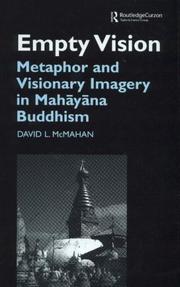| Listing 1 - 4 of 4 |
Sort by
|

ISBN: 1317849108 1317849116 1315829185 9781317849100 9781315829180 1306421527 9781306421522 9780700715534 Year: 2013 Publisher: London : Routledge,
Abstract | Keywords | Export | Availability | Bookmark
 Loading...
Loading...Choose an application
- Reference Manager
- EndNote
- RefWorks (Direct export to RefWorks)
This is a subset of the Sacred Books of the East Series which includes translations of all the most important works of the seven non-Christian religions which have exercised a profound influence on the civilizations of the continent of Asia. The works have been translated by leading authorities in their field.
Book
ISBN: 9788187586593 8187586591 Year: 2013 Publisher: New Delhi: Centre for studies in civilizations,
Abstract | Keywords | Export | Availability | Bookmark
 Loading...
Loading...Choose an application
- Reference Manager
- EndNote
- RefWorks (Direct export to RefWorks)
Buddhism --- Mahayana Buddhism --- Buddhist monasticism and religious orders --- Buddhist art and symbolism

ISBN: 1138862606 1315028972 1136857265 1136857192 9781136857263 9781315028972 9781136857331 9780700714896 9781138862609 Year: 2013 Publisher: London ; New York : Routledge,
Abstract | Keywords | Export | Availability | Bookmark
 Loading...
Loading...Choose an application
- Reference Manager
- EndNote
- RefWorks (Direct export to RefWorks)
Visual metaphors in a number of Mahayana sutras construct a discourse in which visual perception serves as a model for knowledge and enlightenment. In the Perfection of Wisdom (Prajnaparamita) and other Mahayana literature, immediate access to reality is symbolized by vision and set in opposition to language and conceptual thinking, which are construed as obscuring reality. In addition to its philosophical manifestations, the tension between vision and language also functioned as a strategy of legitimation in the struggle of the early heterodox Mahayana movement for authority and legitimacy. T
Mahayana Buddhism. --- Metaphor --- Vision --- Parabole --- Figures of speech --- Reification --- Greater vehicle --- Northern Buddhism --- Northern vehicle --- Buddhism --- Buddhist sects --- Religious aspects --- Buddhism.
Book
ISBN: 9781780231907 9781780232317 1780232314 1299951074 1780231903 Year: 2013 Publisher: London Reaktion Books
Abstract | Keywords | Export | Availability | Bookmark
 Loading...
Loading...Choose an application
- Reference Manager
- EndNote
- RefWorks (Direct export to RefWorks)
The essential elements of a dry Japanese garden are few: rocks, gravel, moss. Simultaneously a sensual matrix, a symbolic form, and a memory theater, these gardens exhibit beautiful miniaturization and precise craftsmanship. But their apparent minimalism belies a true complexity. In Zen Landscapes, Allen S. Weiss takes readers on an exciting journey through these exquisite sites, explaining how Japanese gardens must be approached according to the play of scale, surroundings, and seasons, as well as in relation to other arts--revealing them as living landscapes rather than abstract designs. Weiss shows that these gardens are inspired by the Zen aesthetics of the tea ceremony, manifested in poetry, painting, calligraphy, architecture, cuisine, and ceramics. Japanese art favors suggestion and allusion, valuing the threshold between the distinct and the inchoate, between figuration and abstraction, and he argues that ceramics play a crucial role here, relating as much to the site-specificity of landscape as to the ritualized codes of the tea ceremony and the everyday gestures of the culinary table. With more than one hundred stunning color photographs, Zen Landscapes is the first in-depth study in the West to examine the correspondences between gardens and ceramics. A fascinating look at landscape art and its relation to the customs and craftsmanship of the Japanese arts, it will appeal to readers interested in landscape design and Japan's art and culture.
Gardens, Japanese --- Ceramic sculpture, Japanese --- Zen arts --- Zen Buddhism --- Art, Japanese --- J6586 --- J6640 --- Chʻan Buddhism --- Dhyāna (Sect) --- Zen --- Zen (Sect) --- Buddhism --- Mahayana Buddhism --- Arts, Zen --- Buddhist arts --- Japanese ceramic sculpture --- Zen influences --- Japan: Art and antiquities -- urban planning -- parks and gardens --- Japan: Art and antiquities -- industrial art, craft and design -- ceramics and glassware --- Ceramic sculpture, Japanese. --- Zen arts. --- Zen Buddhism. --- Zen influences.
| Listing 1 - 4 of 4 |
Sort by
|

 Search
Search Feedback
Feedback About UniCat
About UniCat  Help
Help News
News